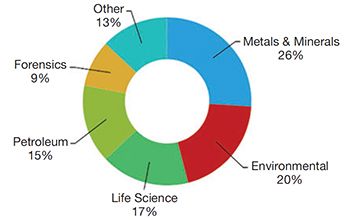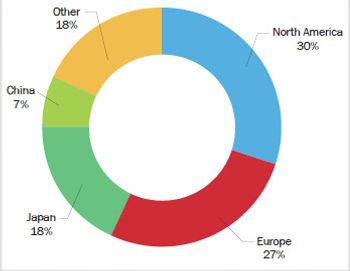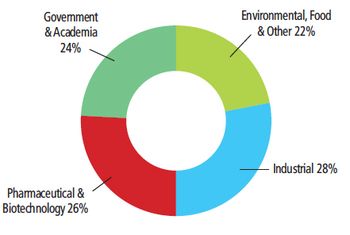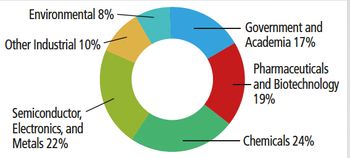
- Spectroscopy-02-01-2020
- Volume 35
- Issue 2
Market Profile: Near Infrared (NIR) Spectroscopy
The total market for NIR was measured at about $470 million in 2019 and is expected to reach over $570 million by 2024.
Near infrared (NIR) spectroscopy can probe material and speciÂmens requiring deep sample penetration without substantial preparation. NIR is based on the absorption of photons at waveÂlengths in the range 780–2500 nm and is used to measure moÂlecular overtone and combination vibrations within these ranges. As in most spectrometers, light is passed through diffraction grating to separate it into individual wavelengths through a sample to the detector. The results are a spectrum of transÂmittance at NIR wavelengths.
At first, NIR instruments were add-ons to UV-vis spectrophotometers before becoming stand-alone systems focused on chemical analysis. Now, monochromators and fiber optics have allowed NIR analyzers to be used in medical and physiological diagnostics, and in research in kinesiology, rehabilitation, and neurology. Industries have also made use of NIR analyzers for bioenergy, forestry, building materials, textiles, and quality assurance. A large portion of NIR instruments are used for food to analyze crops, meat, dairy, beverages to ascertain finished product profiles of density, moisture, protein, oils, and carbohydrates.
The total market for NIR was measured at about $470 million in 2019 and is expected to reach over $570 million by 2024. The fastest growth within this segment is from portable/ handheld NIR analyzers, which is expected to top $100 million in demand by 2024. Scanning & Diode array NIR analyzers account for the largest segment. Environmental and food industries make up over a third of demand by application in 2019 and will continue to be the fastest growing segment due to increased adoption in agriculture. Leading suppliers of NIR instruments are Bruker, Foss, and Thermo Scientific.
Market size and growth estimates were adopted from TDA’s Industry Data, a database of technology market profiles and benchmarks covering laboratory and process analytical instrumentation that are updated quarterly. It also includes data from the 2020 Instrument Industry Outlook report from independent market research firm TDA. For more information, contact Glenn Cudiamat, president & CEO, at (310) 871-3768 or
Articles in this issue
almost 6 years ago
Vol 35 No 2 Spectroscopy February 2020 Regular Issue PDFalmost 6 years ago
Use of Raman Microscopy to Characterize Extractables and Leachablesalmost 6 years ago
Advancing In Situ Applications of Spectroscopy in an Industrial Settingalmost 6 years ago
Raman Spectroscopy of Graphene-Based Materialsalmost 6 years ago
New, Advanced Spectroscopic Techniques Aid in Tissue Engineeringalmost 6 years ago
LIBS-Based Imaging: Recent Advances and Future DirectionsNewsletter
Get essential updates on the latest spectroscopy technologies, regulatory standards, and best practices—subscribe today to Spectroscopy.




